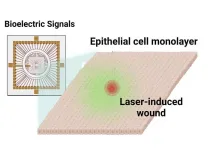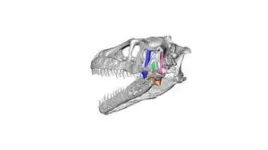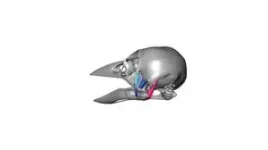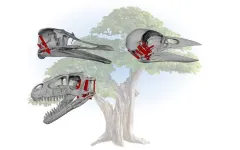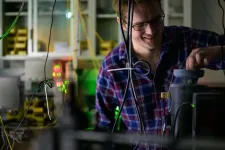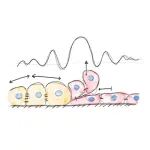(Press-News.org)
EMBARGOED UNTIL 3/17/2025, 3:00PM ET
March 17, 2025
Slow, Silent ‘Scream’ of Epithelial Cells Detected for First Time
Team from UMass Amherst uncovers communication by “electric spiking” in cells once thought to be mute, which could enable bioelectric applications
AMHERST, Mass. — It has long been thought that only nerve and heart cells use electric impulses to communicate, while epithelial cells — which compose the linings of our skin, organs and body cavities — are mute, serving mostly as protective barriers that can absorb and secrete various substances. But two researchers from the University of Massachusetts Amherst have upended the status quo by showing that epithelial cells do indeed “talk” to each other, albeit with slow electrical signals. Led by Steve Granick, Robert K. Barrett Professor of Polymer and Science and Engineering, and postdoctoral fellow Sun-Min Yu, the discovery, published recently in the Proceedings of the National Academy of Sciences, could enable new applications for everything from wearable bioelectric sensors to wound healing.
“Epithelial cells do things that no one has ever thought to look for,” says Granick. “When injured, they ‘scream’ to their neighbors, slowly, persistently and over surprising distances. It’s like a nerve’s impulse, but 1,000 times slower.” His team’s curiosity-driven approach, blending polymer science and biology, unveiled this hidden cellular signaling.
Granick and Yu used an epithelial-cell-coated chip with 60 precisely placed electrodes to eavesdrop. Yu, a cell-culture expert, grew a single layer of human epithelial cells on the chip, which detected minute electric shifts.
Using a precise laser to produce “sting” patterns of individual cells, they watched as signals rippled outward. “We tracked how cells coordinated their response,” Yu explained. “It’s a slow-motion, excited conversation.”
Unlike the swift neurotransmitter bursts of nerve cells, epithelial cells rely on ion flows — of calcium, especially — that produce signals that are far slower than those in nerve cells, but with similar voltages. These signals can be long-lived: Granick and Yu observed cells that “talked” for over five hours across distances nearly 40 times their own length.
Though Granick and Yu showed that calcium ions are necessary for epithelial conversation, they have yet to test what else might contribute to the conversation. And though the immediate applications of their new discovery remain to be seen, the implications are vast.
“Wearable sensors, implantable devices and faster wound healing could grow from this,” Granick noted. “Understanding these screams between wounded cells opens doors we didn’t know existed,” Yu added.
Contacts: Steve Granick, sgranick@umass.edu
Daegan Miller, drmiller@umass.edu
END
Modern birds are the living relatives of dinosaurs. Take a look at the features of flightless birds like chickens and ostriches that walk upright on two hind legs, or predators like eagles and hawks with their sharp talons and keen eyesight, and the similarities to small theropod dinosaurs like the velociraptors of Jurassic Park fame are striking.
Yet birds differ from their reptile ancestors in many important ways. A turning point in their evolution was the development of larger brains, which in turn led to changes in the size and shape of their skulls.
New research from ...
Iguanas have often been spotted rafting around the Caribbean on vegetation and, ages ago, evidently caught a 600-mile ride from Central America to colonize the Galapagos Islands. But for long distance travel, the Fiji iguanas can't be touched.
A new analysis conducted by biologists at the University of California, Berkeley, and the University of San Francisco (USF) suggests that sometime after about 34 million years ago, Fiji iguanas landed on the isolated group of South Pacific islands after voyaging 5,000 miles from the western coast of North America — the longest known transoceanic dispersal of any terrestrial vertebrate.
Overwater ...
UNIVERSITY PARK, Pa. — It may someday be possible to listen to a favorite podcast or song without disturbing the people around you, even without wearing headphones. In a new advancement in audio engineering, a team of researchers led by Yun Jing, professor of acoustics in the Penn State College of Engineering, has precisely narrowed where sound is perceived by creating localized pockets of sound zones, called audible enclaves. In an enclave, a listener can hear sound, while others standing nearby cannot, even if the people are in an enclosed space, like a vehicle, or standing ...
By taking two flakes of special materials that are just one atom thick and twisting them at high angles, researchers at the University of Rochester have unlocked unique optical properties that could be used in quantum computers and other quantum technologies. In a new study published in Nano Letters, the researchers show that precisely layering nano-thin materials creates excitons—essentially, artificial atoms—that can act as quantum information bits, or qubits.
“If we had just a single ...
Backgrounds and objectives
Gastrointestinal complications are common in patients after ischemic stroke. Gastric motility is regulated by gastric pace-making activity (also called gastric myoelectrical activity (GMA)) and autonomic function. The aim of this study was to evaluate GMA, assessed by noninvasive electrogastrography (EGG), and autonomic function, measured via spectral analysis of heart rate variability derived from the electrocardiogram in patients with ischemic stroke.
Methods
EGG and electrocardiogram were simultaneously recorded in both fasting and postprandial states in 14 patients with ischemic stroke and 11 healthy controls. ...
The American College of Cardiology (ACC) has issued its first Concise Clinical Guidance (CCG) to create more streamlined and efficient processes to implement best practices in patient care. This CCG focuses on evaluating and managing cardiogenic shock (CS), addressing important questions around clinical decision-making and providing actionable guidance for health care providers.
“ACC has a long history of developing clinical policy to complement clinical practice guidelines and to inform clinicians about areas where evidence is new and evolving or where randomized data is more limited. Despite this, ...
A new analysis led by surgeons at UCLA Health finds that psychological prehabilitation can significantly enhance recovery after surgery. The research, led by Anne E. Hall in the lab of Dr. Justine Lee analyzed data from 20 randomized controlled trials (RCTs) conducted between 2004 and 2024, involving a total of 2,376 patients. It is published in the Annals of Surgery
What is Psychological Prehabilitation? Prehabilitation is a proactive approach aimed at improving surgical outcomes through preventive measures. Traditionally, ...
Trial of strength at the cellular level: cells are in constant competition with each other and so eliminate diseased or unwanted cells. Cell competition is therefore a central principle for maintaining the health of tissues and organs. Researchers have investigated the success factors of superior cells and discovered a previously unknown winning strategy in mechanical cell competition. They identified a variety in the ability of cells to exert mechanical forces onto other cells as the decisive regulator. With their results ...
Milan, Italy – March 2025 – The Italian Association of Science Writers, SWIM, has announced an extension of the application deadline for the 2025 SWIM Award. Candidates now have until March 31, 2025, at 23:59 CET to submit their applications for the prestigious award, which has been recognizing excellence and innovation in science journalism in Italy since 2021.
The SWIM Award highlights the critical role of science journalists in fostering public understanding and dialogue on scientific issues. The competition also serves as the Italian selection process for the European ...
On first inspection, the Cuban blue-headed quail dove doesn’t look like much: drab brown feathers, a slender beak, a pronounced strut in their walk typical of most other doves. You’d be forgiven for overlooking it in favor of Cuba’s prismatic parrots. But looks aren’t everything. For decades, this unassuming bird has perplexed biologists, who have no idea where it came from, how it got to the island or what it’s related to.
Now, for the first time, scientists have sequenced DNA from the blue-headed quail dove with the goal of finally getting to the bottom of things. Instead, they’re even more perplexed now than when they started.
“This ...
